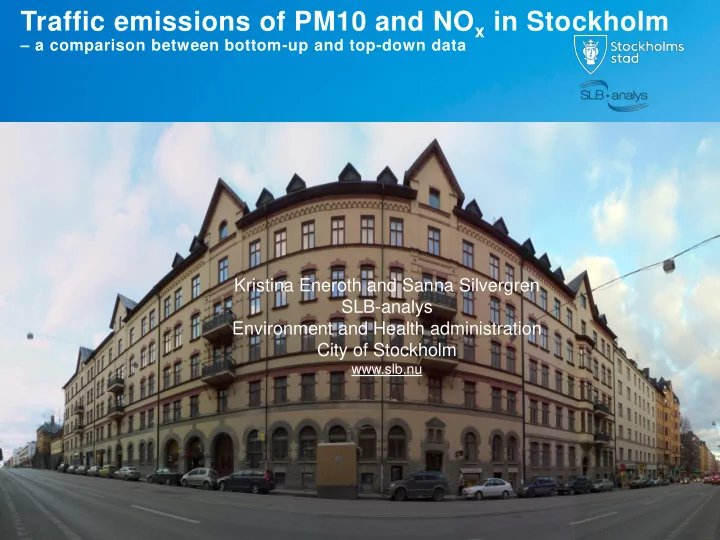

Traffic emissions of PM10 and NO x in Stockholm – a comparison between bottom-up and top-down data Kristina Eneroth and Sanna Silvergren SLB-analys Environment and Health administration City of Stockholm www.slb.nu The Capital of Scandinavia The Capital of Scandinavia
Coordination of air quality monitoring Air quality monitoring in Stockholm but also surrounding counties Eastern Sweden’s Air Quality Management Association • Founded in 1992 • 4 counties • 50 municipalities • ~ 3 million inhabitants (>30 % of total population in Sweden) • Institutes, companies and government agencies 2016-08-17 Page 2
The main purpose and use of our emission databases … • …is to provide input data for modeling – to survey the air quality in the current situation Emission (supplement to measurements) databases – Dispersion future projections at the development of new residential models areas, roads, tunnels, etc. – analyze various measures to improve air quality – calculate the exposure of various air pollutants/ epidemiological studies (time series calculations Measurements backwards in time) • …not reporting emission data and emission trends 2016-08-17 Page 3
Local emissions in Stockholm County SO 2 NO x VOC PM10 CO 2 2016-08-17 Page 4
Road traffic emissions • Road network, signed speed, – National Road Data Base (traffic flow, signed speed, Pneumatic road tube counters road type..) – Traffic measurements and models (traffic flow, real speed, heavy traffic share • Emission models Microwave detectors Video cameras – Exhaust emissions: HBEFA 3.2 – Emissions and resuspension of road dust: Nortrip 2016-08-17 Page 5
Non-exhaust emission model NORTRIP Denby et al 2013 . A coupled road dust and surface moisture model to predict non-exhaust road traffic induced particle emissions (NORTRIP). Part 1: Road 2016-08-17 dust loading and suspension modelling. Page 6
TOD vs BUP Traffic emissions Stockholm City Stockholm County • PM10 Studded tyres – BUP higher emissions of wear-particles • NOx – Vehicle distribution between diesel and BUP higher emissions from diesel vehicles gasoline – BUP lower emissions from gasoline vehicles 2016-08-17 Page 7
Geographical distributions BUP vs TOD 2016-08-17 Page 8
NO x emissions from diesel and gasoline 23% 76% 12% 21% 79% 84%
Trends in diesel and petrol passenger cars 2016-08-17 Page 10
The share of passenger cars with studded tyres in Sweden during winter • Lowest share of studded tyres in NORTH South and Stockholm region • Decreasing trend MIDDLE EAST STOCKHOLM WEST SOUTH NORTH STOCKHOLM MIDDLE WEST EAST SOUTH Swedish Transport Administration’s yearly survey (parked vehicles) 2016-08-17 Page 11
The share of passenger cars with studded tyres in Stockholm during winter TOD: ca 70 % BUP: 50-60 % (depending on road type) Ban against studded tyres • Hornsgatan 1 Jan 2010 • Flemminggatan 1 Jan 2016 • Kungsgatan 1 Jan 2016 • Swedish Transport Administration’s yearly survey (parked vehicles) 2016-08-17 • SLB-anays measurements on passenger cars in traffic Page 12
Emission factors for road wear • SLB-analys emission data base (BUP) – EF based on non-exhaust emission model NORTRIP Denby et al 2013 . A coupled road dust and surface moisture model to predict non-exhaust road traffic induced particle emissions (NORTRIP). Part 1: Road dust loading and suspension modelling. • Swedish air emission inventory for submission (TOD) – default EF from the EMEP/EEA (only direct emissions, not resuspension) – future: SIMAIR model with NORTRIP EF implemented
Summary NO x Emissions of NO x from diesel vechicles Time trend Increase in share of diesel passenger cars 2011<2013 TOD<BUP Geographical The share of diesel passenger cars is higher in Sweden<Stockholm TOD<BUP variation Stockholm compared to Sweden Methodology/EF TOD and BUP both based on Hbefa EF Sum of effects Both time-trends and spatial variation of emissions contribute to TOD is TOD<BUP lower than BUP Emissions of NO x from petrol vechicles Time trend Decrease in share of petrol passenger cars 2011>2013 TOD>BUP Geographical The share of petrol passenger cars is lower in Sweden>Stockholm TOD>BUP variation Stockholm compared to Sweden Methodology/EF TOD and BUP both based on Hbefa EF 2016-08-17 Sum of effects Both time-trends and spatial variation of emissions contribute to TOD is TOD>BUP Page 14 higher than BUP
Summary PM10 Emissions of road wear (PM10) Time trend Decrease in share cars with studded tyres 2011>2013 TOD>BUP Geographical The studded tyre share is lower in Stockholm Sweden>Stockholm TOD>BUP variation compared to Sweden Methodology/EF TOD: EMEP/EEA, direct emissions Sweden<Stockholm TOD<BUP BUP: NORTRIP, direct emissions and resuspension Sum of effects Both time-trends and spatial variation of emissions contribute to higher TOD<BUP emissions in TOD compared to BUP, while the difference in EF used between the two databases contribute to higher emissions in BUP compared to TOD. The different EF gives rise to much greater differences in emissions 2016-08-17 compared to the differences in the proportion of studded tires -> TOD<BUP
Concluding remarks • To understand and analyze the differences between emissions of TOD and BUP it is important to consider: – time trends and geografical variations of the input parameters for the calculations of TOD and BUP emissions – calculation methodology and underlying emission factors for the calculations of TOD and BUP emissions • Only after this is it valuable to study and analyze the more advanced diagrams provided in the Fairmode emission tool 2016-08-17 Page 16
Diamondplot 2016-08-17 Page 17
Thank you! kristina.eneroth@slb.nu 2016-08-17 Page 18
Recommend
More recommend